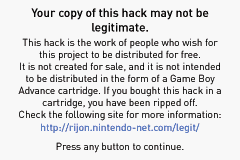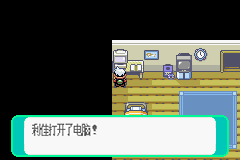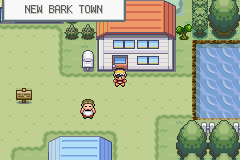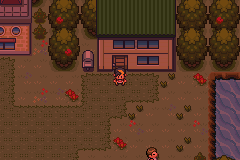ROM hack
- Pokémon Prism redirects here. For the TCG mechanic, see Prism Star (TCG).
A ROM hack is a modified version of a published game created by changing the code of the read-only memory (ROM) to create something new. ROM hacks are popular among certain communities within the Pokémon fandom. Many Pokémon ROM hacks are fan games created by modifying ROM dumps, disassemblies, or decompilations of the official Pokémon games. ROM hacks are typically considered distinct from bootlegs, which are unauthorised copies of published games sold to consumers.

Overview
The core series Pokémon game system is considered very versatile and lends itself well to modification, giving hackers a lot of creative freedom together with a solid, well-tested game engine. These factors, as well as Pokémon's notable popularity throughout the world, has lead to the creation of thousands of different games spanning multiple generations, ranging from minor adjustments to additional new features and, more and more frequently, entirely new fan games. Though the core series is by far the most popular series to hack, there are also many fan games that do not use these as a basis, and instead are based on spin-off games such as the Pokémon Mystery Dungeon series and Pokémon Conquest.
There is a distinction between ROM hacks and bootleg games. Unlike most ROM hacks, bootlegs are unauthorised copies of published games which are sold to consumers, often flashed onto after-market game paks or game cards and lacking the official Nintendo Seal. However, since ROM hacks are often distributed over the Internet for free, they are regularly sold as bootleg games, usually against the hacker's wishes. The reliability of these bootlegs are often poor, and hackers have started to introduce warning screens into their games, cautioning users that if they paid for it, they may have been scammed.
Nintendo is against the practice of ROM hacking and has taken action against it in the past, issuing DMCA takedowns to some ROM hacks.[1][2][better sources needed]
History
Early Pokémon ROM hacks date back to the late 1990s with modified editions of Pokémon Red. These were often relatively minor adjustments such as sprite or dialogue changes, and would generally follow the flow of the original game. These early ROM hacks were infamous for being particularly crude in nature, ranging from swapping Pokémon and human sprites around to replacing the dialogue with obscene text.
This trend continued until the release of Pokémon Brown by user Koolboyman in the early 2000s, one of the most notable Pokémon hacks in history. This was the first hack to completely re-invent the game, with a brand new region and completely new plot. Later editions included an expanded Pokédex (including Pokémon from Generations II, III, and IV), additional dungeons and additional plot tweaks. It is one of the few completed hack games and was successful enough to warrant a sequel (Pokémon Prism, a Pokémon Crystal-based hack) and a Generation III version (Pokémon rijonAdventures) based on Pokémon FireRed.
Since Brown, Pokémon hacking’s notoriety has expanded exponentially, with developers creating many software tools for desktop operating systems to help create maps, edit sprites, graphics and even developing scripting languages specifically for the Pokémon game engine. It has also inspired many hackers to learn how to edit the games' source code directly (known as ASM hacking). Numerous hacks have been released, often using FireRed as a base, such as Pokémon ShinyGold, Pokémon Naranja and the Pokémon Ruby Destiny series, just to name a few. While directly editing the binary data of one of the games was previously necessary to create a ROM hack, it's now far more common to work from community decompilations of the games, as source code (Z80 assembly for Generations I and II, C thereafter) is far easier to write and debug.
There are many websites dedicated to Pokémon ROM hack development. Notable examples include Skeetendo, PHO, and PokéCommunity’s ROM Hack section, the largest known English-language Pokémon ROM hacking community. Many of these sites hold award nominations and ceremonies to showcase some of the best talents of their community.
Game types
Pokémon ROM hacks tend to fall into five vague categories, though due to the huge versatility of the Pokémon engine, some hacks will transcend several categories at once.
Pokédex hacks

These hacks are designed to make all Pokémon available in-game, including first partner Pokémon, event Pokémon, version-exclusive Pokémon, and Pokémon that can only be obtained or evolved through trading, thus allowing the Pokédex to be fully completed in a single playthrough of the game. More advanced hacks will include Pokémon from later generations, often also adding the Fairy-type, newer moves and abilities, and other quality of life features to older games as well. They are often, though not always, named by simply appending the size of the National Pokédex (depending on the generation) to the end of the base game's name, as in "Pokémon Red 151" or "Pokémon Emerald 386". Such hacks will often not deviate too far from the official game story, and are often used in Nuzlocke runs and, more notably, for several runs in Twitch Plays Pokémon.
Difficulty hacks
These hacks, such as Pokémon Radical Red and Pokémon Expert Emerald, also rarely differ from official game in terms of story. They instead have a significantly higher difficulty than usually experienced in regular Pokémon games. They often include extended Pokédex availability and other quality of life features, much like Pokédex hacks. These types of games too are popular amongst Nuzlockers as an additional challenge on top of Nuzlocke rules. Many fans see Pokémon Black 2 and White 2’s Challenge Mode as an acknowledgement of these hacks, though no official link has been made.
ROM bases
These hacks are often designed to be used as a base for other ROM hacks, and often include major revisions to the game’s base code through ASM hacking to add new features such as additional types or a completely re-vamped tileset. Notable features include the introduction of a playable female character into Pokémon Gold, the addition of a Physical/Special split and the real-time clock into Pokémon FireRed, which gives way to a full Day/Night system, a feature that was missed by many fans in Generation III.
Another noteworthy feature is the development of the UPS patch format, which allows the expansion of Game Boy Advance ROM hacks from their original 16MB format to 32MB. This has the advantage of effectively doubling the space available for new maps and graphics, but means the game is only playable under emulation and will crash when played on official Nintendo hardware.
Language hacks

Since the core series games prior to Generation VI were regularly released first in Japan, sometimes months ahead of their international releases, amateur enthusiasts would often translate Japanese-language Pokémon games into English and other languages so they could be played by international audiences. Since the translation was often performed by one or a small group of people, the quality of these translations were often dubious to say the least, the most humorous example being Pokémon Vietnamese Crystal. Nonetheless, these hacks were generally translated well enough to be played and were very popular amongst YouTubers.
In recent years, the core series games have begun releasing simultaneously around the world in more languages and as a result the need for language hacks has somewhat diminished. It does still happen for languages that the Pokémon games are not yet available in, most notably Chinese prior to Generation VII.
Full/complete hacks
These hacks are complete overhauls of the games, with new characters, plots, regions, and features. They often overhaul the game’s graphics, incorporating those seen in later generation games including battle backgrounds, sprites, and map tiles. They will regularly include Pokémon, moves, and types from later generations, and will sometimes include brand new ones created by the hacker. Some hacks, such as ShinyGold and Liquid Crystal, are remakes of entire previously released games, in the same way that FireRed and LeafGreen were remakes of Red, Blue, and Yellow.
Because of the extraordinary amount of work involved by a voluntary hacker or hacking team, few of these games are finished in their entirety and are usually playable in the form of a beta. Most of the notable hacks below are considered to be part of this category.
List of notable core series ROM hacks
With the release of easy-to-use hacking tools for the core series games, there are thousands of ROM Hacks available. What follows is a few notable examples, each with a brief explanation.
Pokémon Quartz
Pokémon Quartz, created by Baro, is considered one of the first complete overhauled ROM Hacks. Though its story is very similar to the original Pokémon Ruby's story, it does have its own original story, locations, and characters. It was also one of the first to include custom tilesets, as well as a completely custom Pokédex of 368 original Pokémon (though they often reused canonical Pokémon's stats).
Pokémon ShinyGold

Pokémon ShinyGold was a Generation III remake of Pokémon Gold and Silver using the Pokémon FireRed engine, echoing how FireRed is a remake of Pokémon Red. Whilst not the first of its kind, it is amongst the most well-known Generation III hacks, despite it never leaving the beta stage. It is also one of the most illegally sold ROM hacks, with many bootleg versions of ShinyGold available as pre-patched ROMs or flashed game paks. ShinyGold's creator, username Zel, included a warning in later editions warning users about this problem and to demand their money back if they had paid for it.
ShinyGold is one of a number of Generation II remakes developed by hackers. Other examples include Pokémon Liquid Crystal and Pokémon CrystalDust, both of which include expanded areas and features, amongst others.
Pokémon Ruby Destiny series

Pokémon Ruby Destiny is a popular series of games based on the Pokémon Ruby engine created by PokéCommunity user destinedJaGold. The series consists of three completed games: Reign of Legends, Rescue Rangers, and Life of Guardians. This series is of particular note, as it is one of the longest running completed hack series available, particularly for its in-depth gameplay and plot. It, like other popular hacks, has even drawn interest from Let's Play creators. The series is also known for incorporating the Fairy type into the Generation III game engine, as well as a user-created "Chaos type", alongside several user-created Pokémon.
A fourth game in the series, Broken Timeline, was in development and would've involved the Eon duo, Latias and Latios, but development for the game has since been cancelled due to destinedJaGold losing interest after going through several plot changes to the story and never getting past the beta stage, and since been done with ROM hacking in general.
Moemon
Moemon (short for "Moekko Monsters", 萌え擬人化 ) is a prominent hack of Pokémon FireRed that changes all Pokémon into gijinka. It is a simple change of FireRed, but with additions such as the ability to catch the three first partner Pokémon, Eevee, and a mix of both LeafGreen and FireRed Pokémon (thus making it simpler to obtain all Pokémon). The game still receives a fair amount of attention, as a patch was released solely for the FireRed hack that updated both the sprites of the Pokémon as well as their menu sprites, functioning like DLC would for any game.
A ROM hack of Emerald has been released as well. Like the FireRed hack, it's a simple change of Emerald, replacing all Pokémon with ginjika counterparts, however, a few aesthetic changes have been applied to both Route 101 and Littleroot Town, adding many puddles to the town, and the Oran Berry has, curiously, been renamed the "Weed Berry", possibly for comedic effect.
Moemon received a short burst of fame when gaming site Kotaku posted an article about it in late 2007.[3]
Pokémon Naranja

Pokémon Naranja is a Spanish hack of Pokémon Ruby in which the player plays as either Ash or Misty and travels around the Orange Islands. Naranja is a Spanish word which means "orange". Celebi appears as this game's mascot. This game is based on the Orange Saga in the anime. The game starts after the player had won the Indigo League. Despite this fact, the player starts with only a Lv. 5 Pikachu. Many characters, plots and events in the Orange Saga are included in the game, such as the GS Ball, Ash's Lapras, the Orange Crew, the Crystal Onix, the Golduck from Bye Bye Psyduck, and Ash's Snorlax. This game is particularly well-polished and features a completely overhauled graphical system, and well as many hours of playtime. Other anime-based hacks include the popular Pokémon AshGray, a FireRed-based game depicting Ash's journey through the Kanto region in the original series.
Pokémon Orange
Pokémon Orange is a ROM hack of Pokémon Crystal made by PiaCRT. Lapras appears as this game's mascot. This hack includes Pokémon from Generations I to VII.
Pokémon TPP Version
Pokémon TPP Version is a hack of Red created for the Season 2 opening run of Twitch Plays Pokémon and developed by users pigdevil2010 and EliteAnax17. The hack was based on an earlier Dex hack named "Pokémon Red 151" by PokéCommunity user Blue, which featured significant level increases across the game as well as making all 151 Pokémon catchable in the wild. On top of the previous changes, Pokémon TPP Version includes additional challenges and features, such as legendary Pokémon respawns, Gym Leader and Elite Four rematches with higher-level teams, and level 100 event battles with Professor Oak and the original Red from the first Twitch Plays Pokémon episode. It also includes the Battle Tent, a Battle Tower-like facility intended for players to earn money without having to repeatedly rebattle the Pokémon League.
This hack is notable as the first ever to be specifically designed for live broadcast, as well as the first to be designed for Twitch Plays Pokémon's unique play style. For example, Mew's cave (a new post-game bonus dungeon accessible from the area of the S.S. Anne after pushing the infamous truck) is filled with numerous holes, making it not too difficult to navigate for a single player but extremely challenging with hundreds or thousands of players controlling the game at once. The game took 39 days in total to complete, with the patch only released after the Twitch community's completion. It is also one of the very few hacks that have been released on a physical cartridge with the hackers' permission as part of a community-led project.
Pokémon Prism
Pokémon Prism was a hack of Pokémon Crystal, created by a team led by Adam "Koolboyman" Vierra over the course of eight years. It is particularly notable for being one of the only Pokémon ROM Hacks Nintendo has issued a DMCA takedown against, merely days before its actual release.[4] This DMCA notice caused the hack infamy, leading to the hack's being released by pirates.[5]
Pokémon Unbound
Pokémon Radical Red
Pokémon Radical Red is a difficulty hack of FireRed created by a team led by Soupercell and koala4 that increases the difficultly significantly compared to the vanilla version. Radical Red adds mechanics and quality of life features from future games in the series and additionally incorporates Pokémon from Generations IV to IX.
This game also adds custom "Seviian forms", regional forms that are native to the Sevii Islands. There are also rules, all of which apply in harder game modes, and are said by Gym guides (in easier game modes, only some of these rules apply):
- Accuracy reducing moves and evasion raising effects have been removed from this game.
- Baton Pass is removed from this game.
- Sleep Clause is in effect, meaning only one Pokémon per team can be put to sleep at a time.
- OHKO moves are removed from the game.
- The bag is inaccessible during boss battles.
- There is a soft level cap before each boss, which reduces EXP gain significantly when the level cap is reached.
- Pokémon will disobey when levelled too far above the level cap.
- Consumable held items come back after trainer battles.
- Battle Style is forced to Set.
- You cannot Thief items from trainers.
- You are automatically healed to full in most boss battles to prevent certain exploits.
Trivia
- The MN character introduced in the English release of Pokémon Red and Blue can be traced back to a partial fan translation patch of the Japanese Pokémon Blue from December 1997 and January 1998 that predates Nintendo of America's announcement of the game in the United States. This has been confirmed by Nob Ogasawara on Twitter,[6] although he misremembered it as a bootleg.
References
- ↑ https://kotaku.com/another-pokemon-fan-game-says-nintendo-shut-them-down-1790360365
- ↑ https://www.techdirt.com/articles/20150911/06482132220/nintendo-hates-you-massive-takedowns-youtube-videos-featuring-mario-bros-fan-created-levels.shtml
- ↑ Kotaku - Pokemon Dressed Up in Moe
- ↑ [1]
- ↑ [2]
- ↑ Nob Ogasawara's tweet on the origins of MN
Related articles
| |||||||||

|
This article is a part of Project Fandom, a Bulbapedia Project that aims to write comprehensive articles on every aspect of the Pokémon Fandom. |




